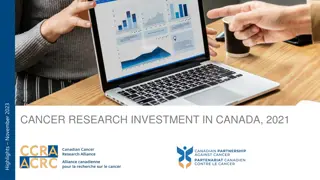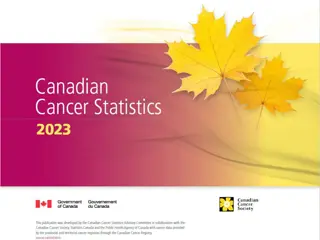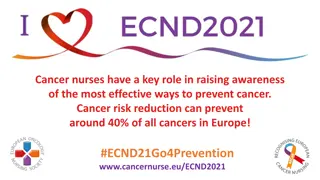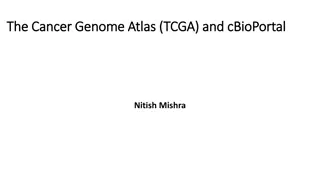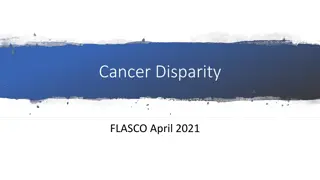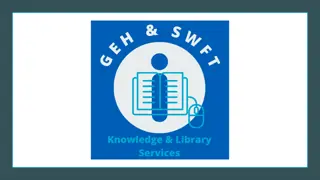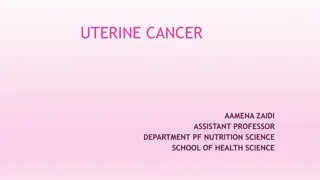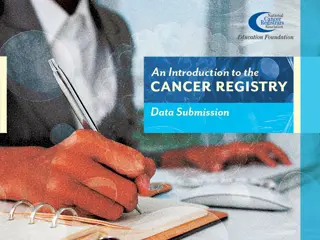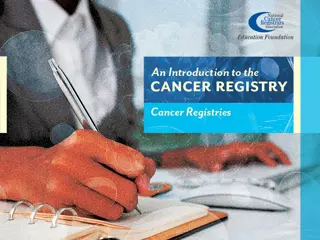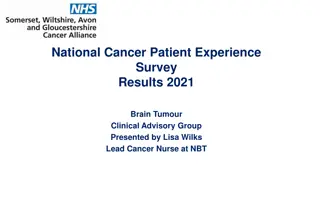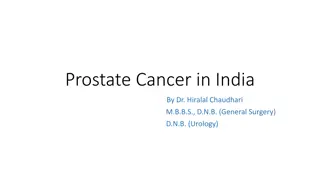Understanding Health-Related Quality of Life (HRQOL) in Young Adults with Cancer
The Health-Related Quality of Life (HRQOL) Working Group conducted a systematic review of literature since 2000 to focus on HRQOL in adolescents and young adults (AYAs) aged 15-39 years with cancer. The study identified gaps in physical, psychological, social, and spiritual/existential aspects, highlighting differences in symptom burden and physical functioning compared to healthy peers and older survivors. The research aimed to provide recommendations for enhancing the HRQOL of young cancer patients and survivors.
Download Presentation

Please find below an Image/Link to download the presentation.
The content on the website is provided AS IS for your information and personal use only. It may not be sold, licensed, or shared on other websites without obtaining consent from the author. Download presentation by click this link. If you encounter any issues during the download, it is possible that the publisher has removed the file from their server.
E N D
Presentation Transcript
Health-Related Quality of Life (HRQOL)
Working Group Brad Zebrack, PhD, MSW, MPH, Co-Chair University of Michigan School of Social Work Lynne Wagner, PhD, Co-Chair Northwestern University, Robert H. Lurie Comprehensive Cancer Center Barbara Jones, PhD, MSW University of Texas School of Social Work Sheila Santacroce, PhD, RN, APRN UNC School of Nursing and Lineberger Comprehensive Cancer Center Anne Kirchhoff, PhD, MPH Huntsman Cancer Institute, University of Utah Nina Kadan-Lottick, MD, MSPH Yale University School of Medicine Erin Kent, PhD NCI Ashley Wilder Smith, PhD, MPH NCI Kelly Trevino, PhD Rowan University Sarah R. Arvey, PhD LIVESTRONG Foundation
Objectives and Strategy To identify gaps and recommendations via a systematic review of HRQOL literature (since 2000) Define search terms Adolescent, Young adult, + (PHYSICAL, PSYCHOLOGICAL, SOCIAL, SPIRITUAL/EXISTENTIAL, MEASUREMENT, METHODOLOGICAL) Google Scholar, PsychInfo, CINHAL Define parameters for inclusion Inclusion (Liberal): aged 15-39 years; younger and older also included; patients, survivors, survivors of childhood cancer Inclusion (Conservative): diagnosis at age 15-39 years Exclusion: sample includes subjects aged <12/13 years or >40 years
Results of Literature Review Records identified through database search Records/Titles screened (Liberal inclusion) Records excluded: Not HRQOL, not 15-39 years Records/Titles screened (Conservative inclusion) Records excluded: Not AYA Psych, Social, Spiritual/Existential Measurement & Methodology Total Physical Liberal inclusion 184 253 68 505 Conservative inclusion 26 105 23 154
HRQOL Content Physical Psychological Social Spiritual/Existential Function Physical activity Symptom burden Fatigue Pain Comorbidities Health behaviors Late effects
Physical Well-Being AYAs report: Poorer physical functioning than healthy peers or siblings (CCSS) Better physical functioning compared to older survivors YAs reported greater symptom burden compared to older adults with the same cancer type Breast: Moderate/severe drowsiness, hair loss, sx interference in relationships Colorectal: Moderate/severe pain, fatigue, nausea, distress, drowsiness, shortness of breath, rash, and greater interference in general activity, mood, work, relationships and life enjoyment Diagnosis, type of treatment, age at treatment completion and time since treatment completion not correlated with HRQL
Physical Well-Being AYAs on treatment have greater symptom burden than those post-treatment, though fatigue persists for years Fatigue and pain negatively affect HRQL AYAs report higher rate of comorbidities (24%) than non-cancer controls (14%), including cardiovascular disease, hypertension, asthma, and disability
Physical Well-Being AYAs report levels of physical activity comparable to controls, below recommended guidelines High proportion of AYAs report being overweight (20%) or obese (15%) with higher rate of obesity among AYAs (31%) than controls (27%) Rates of cigarette use among AYAs estimated at 16% and 26% One study estimated use higher than non-cancer controls (18%) One study found higher rate among age-related peers (25%) and lower rate among older cancer survivors (4%)
HRQOL Gaps Physical Psychological Social Spiritual/Existential Function Physical activity Symptom burden Fatigue Pain Comorbidities Health behaviors Late effects GAPS Other symptoms (e.g., sleep, neuropathy, ADLs) Late effects Biopsychosocial risk factors
HRQOL Content Physical Psychological Social Spiritual/Existential Function Physical activity Symptom burden Fatigue Pain Comorbidities Health behaviors Late effects Psychiatric symptoms Benefit-finding, growth Coping Developmental tasks Identity development Sexuality Peer relations GAPS Other symptoms (e.g., sleep, neuropathy, ADLs) Late effects Risk factors
Psychological Well-Being AYAs report higher prevalence of psychiatric symptoms (compared to normative data, non- cancer controls, older cancer patients) 6%-41% distress Study findings mixed with regard to identifiable risk factors age, time since diagnosis, education, employment status, relationship status, cancer type/severity, treatment type, symptom burden, needs of daily living, fertility concerns, information needs, insurance status, health system characteristics
Psychological Well-Being Coping strategies employed Acceptance, problem-solving Support seeking Emotional expression (through writing, blogs) Seeking normalcy Physical activity Benefit finding, meaning-making associated with positive outcomes Evidence of low levels of receipt/use of psychosocial care
Psychological Well-Being Existing interventions: promote achievement of developmental tasks Identity development, sexuality, peer relationships Intervention modalities reported Expressive therapy through arts, music, video- making, writing, physical activity
HRQOL Gaps Physical Psychological Social Spiritual/Existential Function Physical activity Symptom burden Fatigue Pain Comorbidities Health behaviors Late effects Psychiatric symptoms Benefit-finding, growth Coping Developmental tasks Identity development Sexuality Peer relations GAPS GAPS Other symptoms (e.g., sleep, neuropathy, ADLs) Late effects Risk factors Risk/resilience factors
HRQOL Content Physical Psychological Social Spiritual/Existential Function Physical activity Symptom burden Fatigue Pain Comorbidities Health behaviors Late effects Psychiatric symptoms Benefit-finding, growth Coping Developmental tasks Identity development Sexuality Peer relations Normalcy Social networks Stigma Work/school and socioeconomic status Relationships GAPS GAPS Other symptoms (e.g., sleep, neuropathy, ADLs) Late effects Risk factors Risk/resilience factors
Social Well-Being AYAs compare selves to peers Fertility concerns compromise sense of normalcy Social networks Friends help but offer few opportunities to ask questions, receive information, process feelings, develop coping strategies
Social Well-Being Stigma and unfair treatment From peers, employers, government agencies Challenges in returning to work/school Low SES contributes to poor HRQOL AYAs less likely to be married/partnered; more likely to divorce.
HRQOL Gaps Physical Psychological Social Spiritual/Existential Function Physical activity Symptom burden Fatigue Pain Comorbidities Health behaviors Late effects Psychiatric symptoms Benefit-finding, growth Coping Developmental tasks Identity development Sexuality Peer relations Normalcy Social networks Stigma Work/school and socioeconomic status Relationships GAPS GAPS GAPS Other symptoms (e.g., sleep, neuropathy, ADLs) Late effects Risk factors Risk/resilience factors Risk/resilience factors Family distress/impact Sexual function Body image/appearance Financial well-being Education
HRQOL Content Physical Psychological Social Spiritual/Existential Function Physical activity Symptom burden Fatigue Pain Comorbidities Health behaviors Late effects Psychiatric symptoms Benefit-finding, growth Developmental tasks Identity development Sexuality Peer relations Normalcy Social networks Stigma Work/school and socioeconomic status Relationships Uncertainty Hope and gratitude GAPS GAPS GAPS Other symptoms (e.g., sleep, neuropathy, ADLs) Late effects Risk factors Risk/resilience factors Risk/resilience factors Family distress/impact Sexual function Body image/appearance Financial well-being Education
Spiritual/Existential Well-Being Coping with Uncertainty Expressions of Hope and Gratitude
HRQOL Gaps Physical Psychological Social Spiritual/Existential Function Physical activity Symptom burden Fatigue Pain Comorbidities Health behaviors Late effects Psychiatric symptoms Benefit-finding, growth Coping Developmental tasks Identity development Sexuality Peer relations Normalcy Social networks Stigma Work/school and socioeconomic status Relationships Uncertainty Hope and gratitude GAPS GAPS GAPS GAPS Other symptoms (e.g., sleep, neuropathy, ADLs) Late effects Risk factors Risk/resilience factors Risk/resilience factors Family distress/impact Sexual function Body image/appearance Financial well-being Education Spirituality Religiosity: Development of faith, practice
Methodology and Measurement Lower rates of AYA study participation and retention as compared to older survivors Recruitment strategies vary in effectiveness (as per response rate) Clinic-based recruitment, mailings, social media, population-based (SEER) Online approaches and registries for study recruitment have mixed results re study accrual Study retention increased with use of peer participants, collateral contacts, and parental awareness of participation
Methodology and Measurement Peer outreach (peer-to-peer recruitment) increased retention in health care Online technology effective for intervention delivery Use of social media outlets (e.g., Facebook) for collecting PROs Evidence of higher response bias in reporting inflated levels of socio-emotional functioning
Methodology and Measurement Few HRQOL-specific measures with reported psychometric data Minneapolis-Manchester QOL PedsQOL Cancer Needs Questionnaire Few specific content areas covered by use of standardized measures Fatigue, Pain, Sleep Depression, Distress, Neurocognitive function
Summary HRQOL Content & Gaps Physical Psychological Social Spiritual/ Existential Function Physical activity Symptom burden Fatigue Pain Comorbidities Health behaviors Late effects Psychiatric symptoms Benefit-finding, growth Coping Developmental tasks Identity development Sexuality Peer relations Normalcy Social networks Stigma Work/school and socioeconomic status Relationships Uncertainty Hope and gratitude GAPS GAPS GAPS GAPS Other symptoms (e.g., sleep, neuropathy, ADLs) Late effects Risk factors Risk/resilience factors Risk/resilience factors Family distress/impact Sexual function Body image/appearance Financial well-being Education Spirituality Religiosity: Development of faith, practice
Recommendations Rigorous designs Comparison groups, disease- and treatment-specific sub-groups Longitudinal studies w/repeated measures -- Important given relatively rapid psychosocial & cognitive development Comparative effectiveness evaluations of non-traditional interventions (e.g., videogames, movies, creative arts, social networking) compared to conventional interventions (e.g., psychotherapy, support groups) Instrumentation Deeper evaluation of function, performance, coverage of content, validity, reliability Use of standardized measures and Biomarkers with established AYA reference ranges or community norms Health disparities Identify disparities in symptom burden (physical and psychosocial), and access to supportive care services By AYA characteristics: race/ethnicity, age sub-group, SES, language
Recommendations Intervention studies Reduce symptom burden Promote positive adaptation and coping Target self-efficacy/self-management (symptoms, surveillance of late effects & 2nd malignancies) Involve friends, family, peers Better understanding of role and potential of social networking/social media



